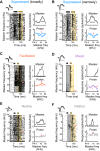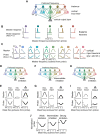Diverse effects of stimulus history in waking mouse auditory cortex
- PMID: 28566458
- PMCID: PMC5558031
- DOI: 10.1152/jn.00094.2017
Diverse effects of stimulus history in waking mouse auditory cortex
Abstract
Responses to auditory stimuli are often strongly influenced by recent stimulus history. For example, in a paradigm called forward suppression, brief sounds can suppress the perception of, and the neural responses to, a subsequent sound, with the magnitude of this suppression depending on both the spectral and temporal distances between the sounds. As a step towards understanding the mechanisms that generate these adaptive representations in awake animals, we quantitatively characterize responses to two-tone sequences in the auditory cortex of waking mice. We find that cortical responses in a forward suppression paradigm are more diverse in waking mice than previously appreciated, that these responses vary between cells with different firing characteristics and waveform shapes, but that the variability in these responses is not substantially related to cortical depth or columnar location. Moreover, responses to the first tone in the sequence are often not linearly related to the suppression of the second tone response, suggesting that spike-frequency adaptation of cortical cells is not a large contributor to forward suppression or its variability. Instead, we use a simple multilayered model to show that cell-to-cell differences in the balance of intracortical inhibition and excitation will naturally produce such a diversity of forward interactions. We propose that diverse inhibitory connectivity allows the cortex to encode spectro-temporally fluctuating stimuli in multiple parallel ways.NEW & NOTEWORTHY Behavioral and neural responses to auditory stimuli are profoundly influenced by recent sounds, yet how this occurs is not known. Here, the authors show in the auditory cortex of awake mice that the quality of history-dependent effects is diverse and related to cell type, response latency, firing rates, and receptive field bandwidth. In a cortical model, differences in excitatory-inhibitory balance can produce this diversity, providing the cortex with multiple ways of representing temporally complex information.
Keywords: auditory cortex; forward suppression; stimulus history.
Copyright © 2017 the American Physiological Society.
Figures










Similar articles
-
Long-lasting modulation by stimulus context in primate auditory cortex.J Neurophysiol. 2005 Jul;94(1):83-104. doi: 10.1152/jn.01124.2004. Epub 2005 Mar 16. J Neurophysiol. 2005. PMID: 15772236
-
Diversity of Receptive Fields and Sideband Inhibition with Complex Thalamocortical and Intracortical Origin in L2/3 of Mouse Primary Auditory Cortex.J Neurosci. 2021 Apr 7;41(14):3142-3162. doi: 10.1523/JNEUROSCI.1732-20.2021. Epub 2021 Feb 16. J Neurosci. 2021. PMID: 33593857 Free PMC article.
-
Suppression of auditory cortical activities in awake cats by pure tone stimuli.Neurosci Lett. 2004 Jul 29;365(3):190-4. doi: 10.1016/j.neulet.2004.04.092. Neurosci Lett. 2004. PMID: 15246546
-
How do auditory cortex neurons represent communication sounds?Hear Res. 2013 Nov;305:102-12. doi: 10.1016/j.heares.2013.03.011. Epub 2013 Apr 17. Hear Res. 2013. PMID: 23603138 Review.
-
Physiological memory in primary auditory cortex: characteristics and mechanisms.Neurobiol Learn Mem. 1998 Jul-Sep;70(1-2):226-51. doi: 10.1006/nlme.1998.3850. Neurobiol Learn Mem. 1998. PMID: 9753599 Review.
Cited by
-
Nicotine Enhances Amplitude and Consistency of Timing of Responses to Acoustic Trains in A1.Front Neural Circuits. 2021 Feb 18;15:597401. doi: 10.3389/fncir.2021.597401. eCollection 2021. Front Neural Circuits. 2021. PMID: 33679335 Free PMC article.
-
Audiovisual task switching rapidly modulates sound encoding in mouse auditory cortex.Elife. 2022 Aug 18;11:e75839. doi: 10.7554/eLife.75839. Elife. 2022. PMID: 35980027 Free PMC article.
-
Movement and VIP Interneuron Activation Differentially Modulate Encoding in Mouse Auditory Cortex.eNeuro. 2019 Sep 18;6(5):ENEURO.0164-19.2019. doi: 10.1523/ENEURO.0164-19.2019. Print 2019 Sep/Oct. eNeuro. 2019. PMID: 31481397 Free PMC article.
-
Parallel pathways for sound processing and functional connectivity among layer 5 and 6 auditory corticofugal neurons.Elife. 2019 Feb 8;8:e42974. doi: 10.7554/eLife.42974. Elife. 2019. PMID: 30735128 Free PMC article.
-
Interpretation of correlated neural variability from models of feed-forward and recurrent circuits.PLoS Comput Biol. 2018 Feb 6;14(2):e1005979. doi: 10.1371/journal.pcbi.1005979. eCollection 2018 Feb. PLoS Comput Biol. 2018. PMID: 29408930 Free PMC article.
References
-
- Anderson JS, Carandini M, Ferster D. Orientation tuning of input conductance, excitation, and inhibition in cat primary visual cortex. J Neurophysiol 84: 909–926, 2000. - PubMed
Publication types
MeSH terms
Grants and funding
LinkOut - more resources
Full Text Sources
Other Literature Sources
Research Materials

